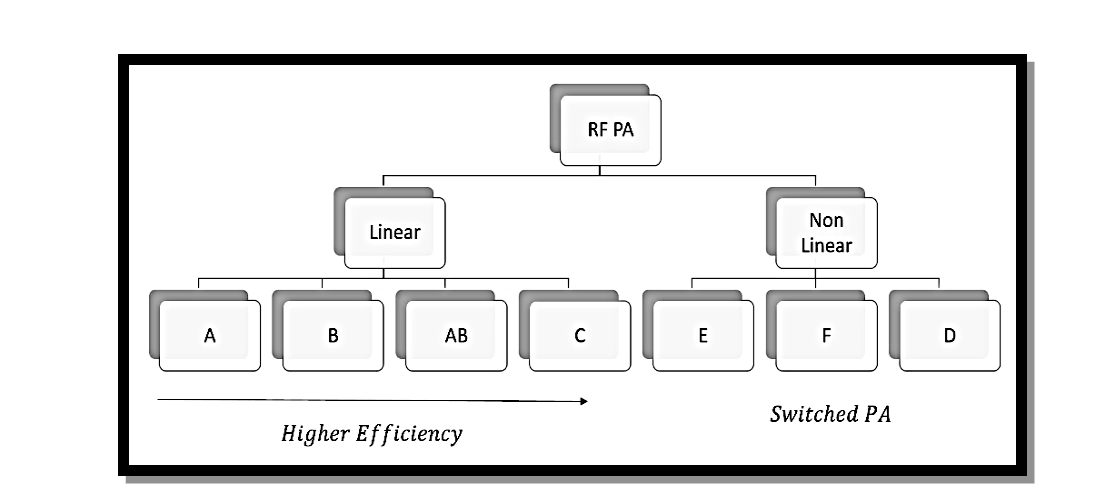
RF Power Amplifiers: Types and Applications
Radio Frequency (RF) Power Amplifiers (PAs) are crucial components in wireless communication systems. They amplify low-power RF signals to higher power levels, enabling effective signal transmission over long distances. RF PAs can be broadly classified into two categories: Linear Power Amplifiers and Non-Linear (Switched) Power Amplifiers. Each category has distinct characteristics, advantages, and applications.
Linear Power Amplifiers
Linear PAs operate with a high degree of linearity, making them suitable for amplitude modulation schemes. This category includes Class A, B, AB, and C power amplifiers. Let’s delve into the specifics of each class:

Class A Power Amplifiers
- Operation: The transistor conducts for the entire input signal cycle (360 degrees).
- Efficiency: Low, around 20-30%, due to constant power dissipation.
- Linearity: High, suitable for high-fidelity amplification.
- Applications: Audio amplification, low-power RF applications.
Class B Power Amplifiers
- Operation: The transistor conducts for half of the input signal cycle (180 degrees).
- Efficiency: Moderate, around 50-60%.
- Linearity: Less than Class A, with crossover distortion.
- Applications: Audio power amplification where efficiency is critical.
Class AB Power Amplifiers
- Operation: The transistor conducts for slightly more than half the input signal cycle (180-360 degrees).
- Efficiency: Between Class A and B, typically around 50%.
- Linearity: Improved over Class B, reduced crossover distortion.
- Applications: Audio amplification, RF transmitters requiring better linearity and efficiency.
Class C Power Amplifiers
- Operation: The transistor conducts for less than half the input signal cycle (less than 180 degrees).
- Efficiency: High, around 70-80%.
- Linearity: Poor, significant signal distortion.
- Applications: High-frequency RF transmission where efficiency is paramount, such as in FM transmitters.
Linear PAs are favored in applications requiring amplitude modulation, such as AM radio, and higher-order modulations like QAM used in modern communication systems. Despite their lower efficiency compared to switched PAs, their ability to deliver higher output power with simpler design complexity makes them suitable for 4G, LTE, and 5G applications.
Non-Linear (Switched) Power Amplifiers
Non-linear PAs, also known as switched PAs, are designed for high efficiency and are suitable for frequency and phase modulation schemes. This category includes Class D, E, and F power amplifiers.
Class D Power Amplifiers
- Operation: The transistors act as switches, toggling between fully on and fully off states.
- Efficiency: Very high, typically around 90%.
- Linearity: Poor, suitable only for digital signals.
- Applications: Audio amplification, RF applications requiring digital modulation.
Class E Power Amplifiers
- Operation: Utilizes a tuned load network to improve efficiency by shaping the voltage and current waveforms.
- Efficiency: Extremely high, can exceed 90%.
- Linearity: Better than Class D, but still not suitable for linear applications.
- Applications: RF applications, particularly where power efficiency is critical, such as in mobile transmitters.
Class F Power Amplifiers
- Operation: Uses harmonic tuning to further improve efficiency and output power.
- Efficiency: Can exceed 80%, with improved power handling capabilities.
- Linearity: Compromised due to the harmonic content.
- Applications: High-efficiency RF transmission, particularly in radar and communication systems requiring high power.
Switched PAs are ideal for applications that prioritize efficiency and power consumption, such as Bluetooth, low-power HF broadcast transmitters, and multiband applications in LTE and other advanced communication systems.
Efficiency and Power Consumption Trade-offs
One of the critical considerations in selecting an RF PA is the trade-off between efficiency and power consumption. Linear PAs, while providing better linearity and higher output power, suffer from lower efficiency, leading to higher power consumption. In contrast, non-linear PAs offer significantly higher efficiency but at the cost of linearity, making them unsuitable for amplitude modulation schemes.
Applications and Design Considerations
- Linear PAs: Preferred in applications where signal fidelity is crucial, such as 4G, LTE, and 5G. The simpler design complexity and higher output power make them suitable for these high-data-rate communication systems.
- Non-Linear PAs: Ideal for applications where efficiency is critical, such as Bluetooth, HF broadcast transmitters, and advanced communication systems using frequency and phase modulation. The higher design complexity, involving harmonic tuning and other techniques, is justified by the significant gains in efficiency and reduced power consumption.
Take our entry level course (Below) for free using coupon code RAHRF101BLOG
RF Fundamentals, Basic Concepts and Components – RAHRF101
For limited time take an additional 10% off of all our courses using coupon code RFCERT10
Rahsoft RF Certificate and courses
Conclusion
Understanding the different classes of RF power amplifiers and their respective applications is vital for designing efficient and effective wireless communication systems. Linear PAs offer higher fidelity and simplicity, making them suitable for modern cellular networks, while non-linear PAs provide unmatched efficiency for specific applications where power consumption is a critical concern. Balancing these trade-offs and selecting the appropriate PA class is essential for optimizing performance in various RF applications.

Learn more about this topic by taking the complete course ‘Linear RF Power Amplifier (PA) Design Theory and Principles online course – RAHRF562’. Watch the course videos for more detailed understanding. Also checkout other courses on RF system and IC design on https://rahsoft.com/courses/. Rahsoft also provides a certificate on Radio Frequency. All the courses offer step by step approach.
Tag:PA, PA Applications, POwer Amplifier



